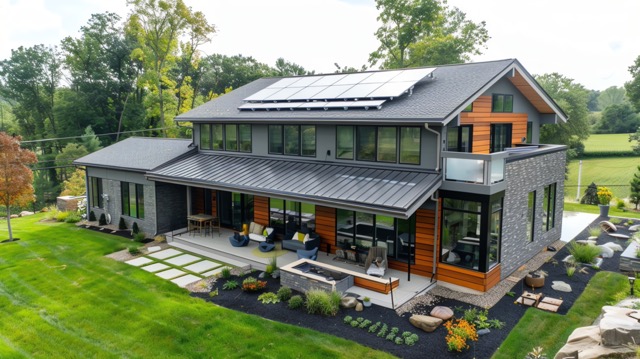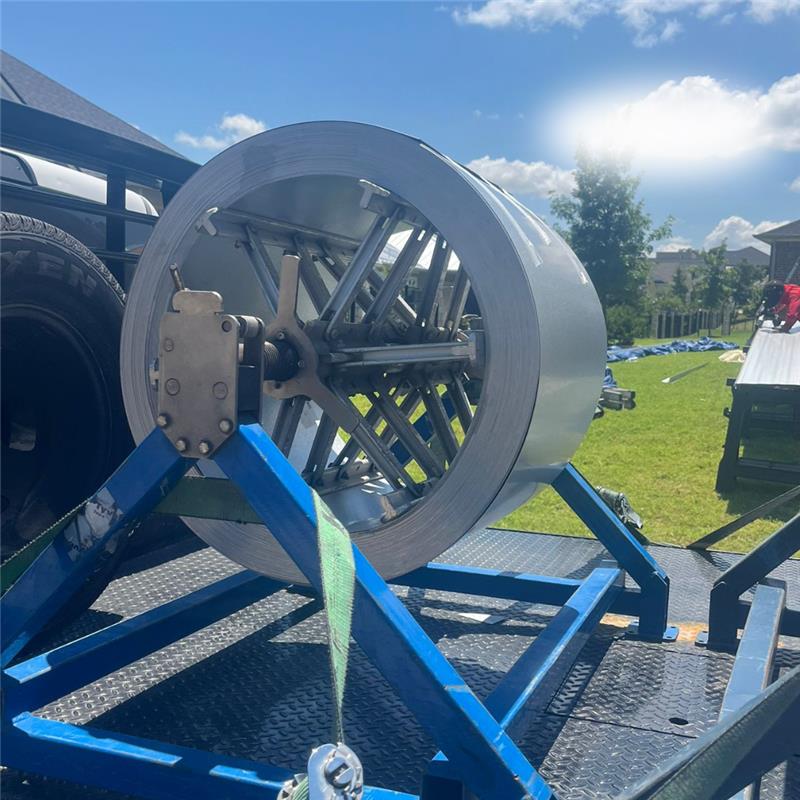Have you ever wondered why metal roofs are becoming so popular in residential and commercial buildings? Sure, they look sleek and modern, but their rising popularity isn’t just about aesthetics. One of the most significant reasons homeowners are choosing metal roofs is their energy efficiency.
Energy efficiency isn’t just a buzzword—it’s a way to save money on utility bills, reduce your environmental footprint, and make your home more comfortable all year round. This article explores how metal roofs contribute to energy efficiency, how they help you save on energy costs, and why they might be the best option for your home’s roofing needs.
1. Introduction: Why Energy Efficiency Matters
Energy efficiency is more than just a trend; it’s a necessity in today’s world. With rising energy costs and growing concerns about environmental sustainability, homeowners are looking for ways to make their homes more energy-efficient. So, where does your roof fit into this picture?
The roof is a significant factor in determining how energy-efficient your home is. Whether you’re looking to keep your home cooler in the summer or warmer in the winter, choosing the right roofing material can make a big difference in how much energy your home consumes. That’s why metal roof energy efficiency is such an important topic for homeowners to consider.
2. How Metal Roofs Contribute to Energy Efficiency
Metal roofs are highly regarded for their energy-efficient properties, and it’s not just because they look shiny and modern. So, what exactly makes a metal roof so energy-efficient?
First, metal roofs reflect a significant portion of the sun’s rays, preventing heat from being absorbed into your home. Unlike traditional roofing materials like asphalt shingles, which tend to absorb heat, metal roofs act like a protective barrier, bouncing the heat away. This keeps your home cooler in the summer, reducing the need for air conditioning.
3. Reflectivity: Metal Roofs and Solar Heat
One of the most important factors in metal roof energy efficiency is reflectivity. Reflectivity refers to the ability of a material to reflect solar energy back into the atmosphere rather than absorbing it. Metal roofs, especially those with reflective coatings, excel at this.
Think of a metal roof like a mirror on a hot summer day. Rather than soaking up all that heat and warming up your home like an oven, the metal roof reflects the sun’s rays, keeping the interior cooler. This not only reduces the temperature inside but also lowers the amount of energy your cooling system needs to expend.
4. Cool Roof Coatings and Energy Savings
Many metal roofs come with specialized coatings known as cool roof coatings. These coatings are designed to further enhance the roof’s ability to reflect solar energy. By increasing the reflectivity of your roof, these coatings can help reduce the overall temperature of your home by several degrees.
Cool roof coatings can be compared to putting on sunscreen before heading out on a sunny day. Just like sunscreen protects your skin from UV rays, cool roof coatings protect your home from excessive heat. This can lead to significant energy savings, particularly during the hot summer months when cooling costs can skyrocket.
5. Insulating Properties of Metal Roofs
While metal roofs are excellent at reflecting heat, they also offer insulation benefits. Many modern metal roofing systems include insulating layers that help regulate your home’s temperature. This combination of reflectivity and insulation provides year-round energy efficiency.
In colder months, these insulating layers help keep warmth inside your home, reducing the need for excessive heating. So, whether it’s hot or cold outside, a metal roof works double duty to keep your energy usage—and your bills—low.
6. Energy Efficiency in Summer: Beating the Heat
One of the biggest advantages of a metal roof is how it performs during the summer. When temperatures soar, many traditional roofing materials absorb heat, making your home feel like a sauna. This forces your air conditioning system to work overtime, driving up energy costs.
However, metal roofs are designed to keep your home cooler by reflecting the sun’s rays and reducing heat absorption. This means that your air conditioner can take a well-deserved break, and you can enjoy a cooler home without cranking up the AC.
7. Energy Efficiency in Winter: Retaining Warmth
While metal roofs are great at keeping heat out in the summer, they’re just as effective at keeping warmth inside during the winter. How does that work?
It’s all about insulation. Metal roofs, particularly those with insulated panels, help retain heat during the colder months. This reduces the need for excessive heating, ensuring that your energy bills stay manageable, even when temperatures drop.
In essence, a metal roof acts like a thermal blanket for your home, keeping it cozy and warm throughout the winter.
8. Metal Roofs and Reduced HVAC Strain
One of the hidden benefits of metal roofs is how they reduce the strain on your HVAC system. Because metal roofs help regulate your home’s temperature by reflecting heat and providing insulation, your heating and cooling systems don’t have to work as hard.
Imagine if you were running a marathon every day—that’s what your HVAC system feels like when it’s constantly battling extreme temperatures. A metal roof takes the pressure off, allowing your HVAC system to operate more efficiently and last longer. This not only leads to energy savings but can also reduce repair and replacement costs for your heating and cooling systems.
9. The Role of Ventilation in Energy Efficiency
Ventilation plays a crucial role in maintaining energy efficiency with metal roofs. Proper ventilation systems help regulate attic temperatures and prevent heat buildup, which can make your home more comfortable and energy-efficient.
By allowing air to circulate properly, ventilation systems work hand-in-hand with the reflective and insulating properties of metal roofs. This synergy ensures that your home remains cool in the summer and warm in the winter, all while reducing energy usage.
10. Comparing Energy Efficiency of Metal Roofs to Other Roofing Materials
When it comes to energy efficiency, how does a metal roof compare to other common roofing materials? Let’s take a look:
- Asphalt Shingles: While affordable, asphalt shingles absorb heat and can raise your home’s temperature, leading to higher cooling costs.
- Wood Shingles: Wood has natural insulating properties but lacks the reflective capabilities of metal roofs, making it less energy-efficient in hot climates.
- Clay or Concrete Tiles: These materials provide some insulation but are heavier and may not reflect as much heat as a metal roof.
Overall, metal roofs outperform these traditional materials in terms of both heat reflectivity and insulation, making them the superior choice for energy-conscious homeowners.
11. Environmental Benefits of Metal Roofs
In addition to saving energy, metal roofs offer a range of environmental benefits. For one, they are often made from recycled materials, and at the end of their lifespan, they can be fully recycled again. This makes metal roofing one of the most sustainable roofing options available.
Additionally, by reducing your home’s energy consumption, metal roofs help lower your carbon footprint. Whether you’re looking to go green or simply reduce your energy bills, metal roofs are a smart, environmentally friendly choice.
12. Metal Roof Color and Its Impact on Energy Efficiency
Believe it or not, the color of your metal roof can impact its energy efficiency. Lighter colors, like white, silver, or light gray, reflect more sunlight and can help keep your home cooler in hot climates. These colors are often referred to as “cool colors” because of their ability to reduce heat absorption.
Darker colors, on the other hand, absorb more heat. While they may not be as effective at reflecting sunlight, they can still provide energy efficiency benefits thanks to the metal roof’s reflective coatings and insulating properties. Ultimately, the best color for your metal roof depends on your climate and personal preference.
13. Long-Term Savings: Lower Energy Bills with Metal Roofing
One of the biggest draws of installing a metal roof is the potential for long-term savings. While metal roofs may have a higher upfront cost compared to traditional roofing materials, the energy savings over time can more than make up for the initial investment.
By reducing your heating and cooling costs, a metal roof can help you save hundreds or even thousands of dollars on your energy bills over its lifespan. Plus, many homeowners find that metal roofs increase the resale value of their homes, making it a smart financial choice in the long run.
14. How to Maximize the Energy Efficiency of Your Metal Roof
To get the most out of your metal
roof’s energy-efficient properties, consider the following tips:
- Choose a reflective coating: Opt for cool roof coatings that enhance reflectivity and further reduce heat absorption.
- Pick the right color: If you live in a hot climate, choosing a lighter color can help keep your home cooler.
- Ensure proper ventilation: Good ventilation is key to maintaining energy efficiency, so make sure your roof is equipped with the right ventilation system.
- Consider insulation: Adding insulation beneath your metal roof can provide extra protection against temperature fluctuations, especially in colder climates.
By following these steps, you can ensure that your metal roof delivers maximum energy savings and comfort.
15. Conclusion: Why Metal Roofs Are the Smart Choice for Energy Efficiency
In today’s energy-conscious world, making your home more efficient is a top priority. A metal roof not only enhances the overall appearance of your home but also offers significant energy efficiency benefits. From reflecting solar heat to providing insulation, metal roofs help keep your home comfortable year-round while reducing your energy bills.
Investment in a metal roof means investing in long-term savings, durability, and a reduced environmental footprint. When it comes to energy efficiency, metal roofs are a clear winner.
FAQs on Metal Roof Energy Efficiency
- How do metal roofs help with energy efficiency?
Metal roofs reflect solar heat and provide insulation, reducing the need for heating and cooling, which lowers energy consumption. - Do metal roofs work well in hot climates?
Yes, metal roofs are excellent for hot climates because they reflect sunlight, keeping homes cooler and reducing air conditioning costs. - Can a metal roof help save on energy bills?
Absolutely! Metal roofs reduce the need for heating and cooling, leading to lower energy bills over time. - What is a cool roof coating?
A cool roof coating is a reflective layer applied to a metal roof that enhances its ability to reflect heat, making it even more energy-efficient. - Is there a best color for energy-efficient metal roofs?
Lighter colors like white or silver are more energy-efficient as they reflect more sunlight, keeping your home cooler. - Do metal roofs keep homes warm in the winter?
Yes, metal roofs help retain heat in the winter, thanks to their insulating properties, reducing the need for heating. - Are metal roofs environmentally friendly?
Yes, metal roofs are often made from recycled materials and are fully recyclable at the end of their lifespan. - Do metal roofs require more maintenance to stay energy-efficient?
Metal roofs require minimal maintenance, but regular inspections and keeping the roof clean can help maintain its energy efficiency. - How does ventilation impact a metal roof’s energy efficiency?
Proper ventilation prevents heat buildup, allowing the roof to work more efficiently by maintaining a consistent indoor temperature. - Can a metal roof increase the resale value of my home?
Yes, metal roofs often increase home resale value due to their energy efficiency, durability, and environmental benefits.
With more than 50 years of experience in manufacturing and metal roof installation, Fasteel – Metal Roof Solutions designs, manufactures, and distributes metal roofing products, including coils, flat sheets, panels, trims, and accessories. Our services include breaking metal, on-site manufacturing, small batch production, and plans and blueprint interpretation to ensure the most accurate estimate. With manufacturing facilities and warehouses in San Antonio and Houston, we cover the entire Dallas, Austin, San Antonio, and Houston metroplex areas. In addition, we have a fleet of high-tech roll formers that allows us to expand our coverage to anywhere in the continental United States of America.






